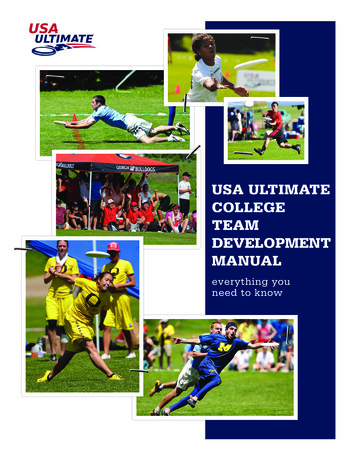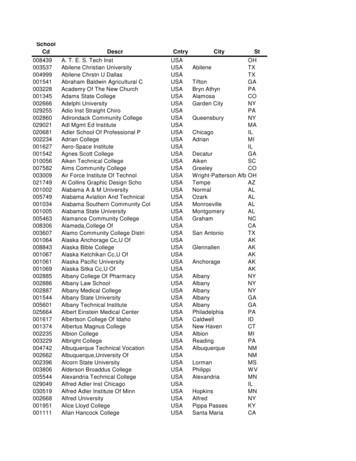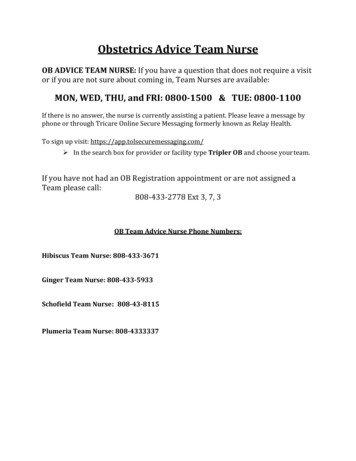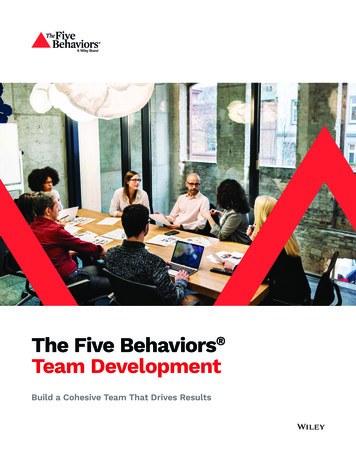
Transcription
USA ULTIMATECollegeTeamDevelopmentManualeverything youneed to know
Official Disc Sponsor of USA UltimateCopyright 2004 USAURevised 4/2011Boulder, COUSA 303.447.3472
table of contentsINTRODUCTION. . 4TESTIMONIALS. . 5what is USA Ultimate?. . 6What is ultimate?. .6spirit of the game . .6getting started. 7preparation.7Recruitment and retention.8establish means of communication. 10first meeting. 10leadership roles. . 11fields. 12equipment. 13become accredited with your college or university. 14Insurance. 14fundraising. 15competition. 17USA Ultimate college season. . .18Season wrap.18team marketing guide.19sample practice schedule.20SAMPLE FLYER.21SAMPLE LETTER TO COLLEGE administrator.22sample bylaws.23SAMPLE BUDGEt.25sample sponsor flyer.263
INTRODUCTIONStarting a new Ultimate team at your school will be one of themost rewarding adventures you embark on. Bringing a new teamtogether can be a challenge. But you can accomplish any goal ifyou put your heart and mind into it. The experience will teach youabout yourself, strengthen your organizational and business skillsand give you opportunities to travel and spend time with someof the greatest friends you will ever make. Once you have a team,you will wonder how you managed without one.This manual is designed to take you through many of the stepsinvolved with creating a new college Ultimate team. Gettingstarted will take a lot of work. But before long you will bespending time playing the sport you love with friends who want todo the same.Share your love for Ultimate by getting others involved in one ofthe fastest growing sports in the world. Ultimate brings out thebest in people. Your efforts will create new friendships, open upopportunities to play and help others get in shape and have fundoing it. Marvel at all you can accomplish as a TEAM!Thank you for supporting Ultimate in your community!Melanie ByrdDirector, Membership and Sport DevelopmentUSA Ultimate4
TESTIMONIALSThe first year or so was tough, with lownumbers and numerous challenges. Wekept pushing through, and now in our thirdyear we are seeing huge successes! The best thingabout starting this team is seeing the friendships andsupport that it provides for its members. I’m glad I’llbe leaving a lasting legacy like that at Vanderbilt.Katie PattersonVanderbilt Women’s UltimateThe first couple of years were certainlythe hardest; getting ten people to practicewas a major struggle. Covenant Ultimatefinally reached critical mass, outperforming all myexpectations and attending D-III Nationals my senioryear. More importantly, the team now has a strongleadership framework which promotes the sport oncampus, recruits new players, and structures practicesso that players at all levels are learning and improving.Ben SladeCovenant College Ultimate (student body 1100)Coming out of high school I helped tofound our team and bring together a greatgroup of girls. In our second year now, wehave over 20 girls involved and even though many arebeginners, everyone’s having a great time learning andplaying together.It’s stressful and hard work but it is thebest feeling in the world watching a newteam go to their first tournament and taketo the culture of Ultimate.Jon KallinRamapo College of New JerseyOne of the greatest pleasures of startingthe Ultimate team would be the people youmeet. When you combine Ultimate playerswith college students, there is a magical craziness bornthat attracts these weird and fun people. The mostrewarding part of starting a team was the friends Imade and the moments we shared; I believe this is whythe team became so successful.Robert RathgeberBloomsburg UniversityStarting an Ultimate team is venturing intothe unknown of sports. It’s broadcasting toothers that they are more important thanthe outcome of a game. Whether or not you are readyfor it, you have started a family.Dan FiorinoDePaul UniversitySarah ChoreySanta Clara University Women’s UltimateStarting an Ultimate Frisbee Team wasthe best thing I’ve ever done and the hardwork totally paid off. In the beginning therewere few .Once people enjoyed coming out weekly forpickup games, we started incorporating techniquesand drills, and eventually evolved into a competitivecollegiate team. If a frisbee team can blossom inFresno, then a frisbee team can start anywhere.Chris MaloneyFresno State Ultimate5
what is USA Ultimate?The national governing body of the sport in theUnited States, USA Ultimate (USAU) is the largestmembership organization in the world devoted entirelyto the sport of Ultimate. A not-for-profit organizationbased in Boulder, Colorado, USAU was founded in1979 to promote and support the sport of Ultimateand its players and to increase participation at alllevels. For up-to-date information regarding USAUmembership, visit www.usaultimate .org/membership.The organization is governed by a board of directorscomposed entirely of volunteers elected by USAUmembership, with day-to-day operations directed by asmall professional staff.USAU serves as the governing body for the sport ofUltimate in the U.S. Our mission is to advance the Sportof Ultimate in the United States by enhancing andpromoting Character, Community and Competition.What is Ultimate?Ultimate is a non-contact disc sport played by twoteams of seven players with a high-tech plastic disc ona field with two end zones. The objective of the gameis to score by catching a pass in the opponent’s endzone. A player must stop running while in possessionof the disc, but may pivot and pass to any of the otherreceivers on the field. Ultimate is a transition game inwhich players move quickly from offense to defenseon turnovers that occur with a dropped pass, aninterception, a pass out of bounds, or when a player iscaught holding the disc for more than ten seconds.Although Ultimate resembles many traditional sportsin its basic athletic requirements, the rules are simplerwhich allow the game to be self-officiated. The conceptof Spirit of the Game is integrated into the basicphilosophy of the sport, is written into the rules and ispracticed at all levels of the game.Ultimate was developed in 1968 by a group ofstudents at Columbia High School in Maplewood,NJ. The first official rules of the game were recordedin 1970. One of the fastest growing sports in theworld, Ultimate is played in more than 42 countriesby hundreds of thousands of men and women,girls and boys. According to the Sports and FitnessParticipation Report conducted by the Sporting GoodsManufacturers Association, over 895,000 people playUltimate in the U.S.Spirit of the Game Ultimate relies upon a spirit of sportsmanship whichplaces the responsibility for fair play on the player.Highly competitive play is encouraged, but never at theexpense of mutual respect among players, adherenceto the agreed upon rules of the game, or the basicjoy of play. Protection of these vital elements servesto eliminate adverse conduct from the Ultimatefield. Such actions as taunting of opposing players,dangerous aggression, belligerent intimidation,intentional fouling, or other “win-at-all-costs” behaviorare contrary to the Spirit of the Game and must beavoided by all players.6
getting startedPreparationStarting a new college team can be a challenge, butwith some initial effort you can form a solid foundationfor your team that will make it easier to maintain in thelong run. People want to play Ultimate and once theystart it doesn’t take long before they are hooked!Newcomers to Ultimate may feel a little nervous, shy,or doubtful of their ability to play. To accomplishyour goal of getting participants to join your team, itis important to focus on creating a fun and friendlyatmosphere to welcome new players. If you aresuccessful at bringing a group together and fosteringfriendships, then their desire to play and compete as ateam will follow.Ideally you will have enough time (preferably severalweeks or a couple of months) to take care of some ofthe logistics for starting your new team. If you takethe time to do this the right way, you will be preparedwhen players express interest in joining the team. Theprogram will run more smoothly and your new recruitswill be more likely to continue coming out.In order to give your new team its best shot atsucceeding, it is important to explore your optionsand prepare for obstacles ahead of time. Bringing newplayers into an organized and well-thought out activitywill foster a feeling of confidence and help to lessenfrustrations. Remember that the more work you putinto preparing for this, the easier it will be to maintain.Take a look at the following suggestions and see whatyou can do to prepare for your new team.7
Recruitment and RetentionMany programs struggle initially to get enough playersto have effective practices and be able to travel totournaments. It may seem that you can’t recruitenough people to play. But more often than not, theissue lies not with recruitment but with retention.Many people may come to try it out and not return. Itis important to work hard to recruit. The whole teamshould be involved in this effort. But you must workextra hard to retain the new players by creating anexperience they will want to return for.Ideally you would start getting a team together in thefall. During this time people are looking for things toget involved in and this leaves you with plenty of timebefore the spring college season to develop team skillsand interest in the sport.RecruitingRecruiting new players should involve the efforts ofeveryone on the team. Your current players love thesport and understand reasons for playing and they are,therefore, the ones that can best market your program.To help teammates get involved it is good to outline amarketing strategy with helpful tips for promoting yourteam and Ultimate.development and provide students with a schoolcontact and advocate for your program.» Distribute and hang posters. Use posters from thekit, print out posters or email electronic versionsof flyers available online at www.usaultimate.org/resources/development/college. A sample flyerand the information it should contain is includedin this manual. Post in dorms, recreation centers,club sports buildings, student centers, dininghalls, weight rooms, libraries, building lobbies,student commons, etc. Use professional lookingposters and brochures.» Target your audience. Invite athletes that playdifferent sports. Because of the similarities, manysoccer players pick up Ultimate in the off-seasonand find the friendly atmosphere and lack ofreferees refreshing. Is there an Ultimate intramuralleague?» School resources for marketing your program mayinclude the school newspaper or radio station,free website space, advertising in the studenthandbook and special opportunities to set upinformation booths during freshman orientationweek or club sports fairs.»C reate a brochure or handout to distribute tointerested parties and new players at practice.Ideas for promoting your Ultimate team:»T alk with everyone you can about the sportof Ultimate and what makes playing so great.Marketing the program by word of mouth will havethe greatest impact on recruiting new players.Provide current teammates with a copy of theTeam Marketing Guide in this manual and offerincentives to students who bring in new players.»P urchase the College Team Development Kit. Thekit includes posters, cones, discs, an instructionalDVD, skills and drills manual and additionalmaterials helpful for organizing your team.» I dentify a faculty adviser. Faculty Advisors listento concerns and questions and are an invaluablementor for students, assist students in developingand enriching the program, may assist in thegeneral operation of the club, are knowledgeableabout school resources, policies and procedures,encourage and support a students’ individual8It may take countless efforts to receive just a fewresponses. Be persistent and you will get a team. Youmust sell the sport and your team. Remember thatrecruitment is an ongoing process. You will always neednew players to replace ones that leave.RetentionRecruiting new players to come out is one thing, butgetting them to stay is another. The real work comeswith keeping the interest of new players long enoughfor them to discover their own passion for the sportand being part of a team.Many players will contact you or visit your teampractices. But not all of them will return. Retainingplayers is something that is in your control and you mustwork hard to understand the needs of new players. Hereare some suggestions for things to consider:
» Start with introductions. Welcome everyone to theteam and learn everyone’s name. This is criticalin making people feel important and like part ofthe team.»P lan organized practices. Minimize down time.Don’t waste your players’ time. Maintain interestby keeping things structured and focused.Consider the different options based on thenumber of players that will attend.»F oster a learning environment. Players want tofeel challenged to learn new skills and makeimprovements during practice. Focus initially onintroducing basic skills and keep scrimmaging toa minimum. Players want to understand what it isthey are supposed to do before being thrown in asituation. Mix things up, keep them interesting.»M entoring. Match new players up with experiencedplayers. The experienced player is responsible forhelping the new player feel welcome, encouragingthem to return and partnering up at practice whenappropriate.»H elp players feel successful. Enforce good effortswith positive feedback. Keep constructive criticismto a minimum. Offer opportunities for playercomments and questions. Treat each individualas an equally valuable part of the team. Let preseason practices be more focused on teaching newplayers than supporting the experienced.»T eam bonding. Many players will join for the socialaspect of meeting new people. While people thatstick with it will come to love the sport itself, itis important to do things that encourage andpromote friendships amongst the players. Askanyone who plays Ultimate what they like aboutthe sport, and they will answer, “The people”.»A ttention. Players that receive one-on-onecommunication time feel valued and improve at anincreased rate.You can’t recruit too many players to a newteam. Encourage as many people to join as possible.People will drop by and some won’t return. But manywill feel the excitement and want to get involved.Retention Advice for Women’s TeamsCollege women typically begin playing the sport forone of two reasons: 1) they are athletes looking fora new sport or 2) they are looking for a group offriends. Determining which group individuals fall into isimportant in order to understand what motivates themand what will encourage them to stick with the sport.The first group of players will likely be competitorswho want to win and who will be motivated by thechallenge of figuring out the intricacies of a newsport. These players should be given specific feedbackabout their performance in both group and individualsettings. They will thrive in an environment wherethere is a strong element of competition and wherethe bar is constantly being raised. Incorporate headto-head drills into practices and match them up withother competitive rookies and returning players whowill challenge them to improve. At tournaments, havethem guard the other team’s best players and let themstruggle—this will leave them hungry for more.On the other end of the spectrum are the players whojoin for the social aspect of being on a team. While theseplayers may approach competition differently, they haveas much potential to contribute to the team as playersin the first group. However, they may be more sensitiveand may need more positive feedback and one-on-oneinteraction than other players. These players will thrivewhen they feel positively connected to and supported bytheir teammates. It is important to create opportunitiesfor players to interact outside of practice; encourageplayers to support each other in their off-field endeavors,cook team dinners together, volunteer for a worthycause as a team, and just generally spend time together.This will provide players in this second group with theenvironment that they need to succeed.Ultimate brings people from many walks of life togetherand by teaching your team how to build on thesedifferences, you will be able to build a thriving Ultimateprogram. College women’s teams have a strong senseof camaraderie—this means an environment whereplayers push each other hard at practice, as well asenjoy college life together. This sense of team andtogetherness is appealing to many women.9
Establish Meansof CommunicationMake sure there is a vehicle for team communication.Obtain contact information for all of the players.Create a team listserv and add everyone to it. Bevigilant and quick to respond to inquiries. Electroniccommunication tools such as e-mail, Facebook andTwitter will likely become your most efficient wayto communicate with the team. Use these tools toaddress issues raised at practice, send out practicereminders, acknowledge team efforts, or plan socials.Build an online publication or site for the team andencourage group engagement.Provide team contact lists to all players. This enablesthem to reach out to one another, schedule timesto throw outside of practice or catch rides together.Help players feel part of a team. Provide them withthe means for communicating with you and otherteammates.FIRST MEETINGSchedule your first team meeting in the beginning tokick things off or soon after things get started. Thismeeting will be your opportunity to help organize andunite the team. Use this meeting to get the programoff to a good start. Plan the meeting carefully andcome prepared.to announce the team vision or you may chooseto determine the team vision based on responsesfrom the players. Just remember that team buy-in isimportant. Things to consider when determining yourteam’s vision may include:» What is your ideal team experience?» Will there by tryouts?» Will you compete in tournaments?» When is your playing season?» What would you like to accomplish as a team?» Will you allow practice players that don’t wish tocompete?» What level of commitment is expected fromindividuals?» What are expectations outside of practice?» Will there be a focus on the social aspects of beinga team?Identify Team NeedsThe needs for each team vary. Work with your team todetermine needs and brainstorm solutions. Followingare some suggestions for things that most teams willneed to address. For more information about theseneeds, see the section on Leadership Roles.» Coach» LeadershipMeeting LogisticsChoose a location that will be private and allowthe participants to be focused. A school classroomor conference room is ideal. Avoid restaurants orpublic places. Make sure it is easily accessible. Whenselecting a meeting time, keep in mind that you mustwork around school schedules.Define Team VisionEstablishing the team’s vision will provide the groupwith a focus and form a foundation for your teamfrom which many future decisions will be based upon.Visions vary from team to team. You may choose10» Funds/Budget» Fields/Insurance» Web/Tech» Player Logistics» Competition Logistics» Club Sports
ScheduleEveryone is here because they want to play! If afield site has been secured then establish a practiceschedule. At a minimum determine a time and meetingplace to get together and throw.Wrap UpEveryone should leave this meeting with a clearunderstanding of what is coming next, what theirresponsibilities are, and what it means to be a partof the team. Come prepared with information and/orhandouts to help answer questions participants mayhave. Some questions may include:» What is the estimated cost for someone to play?» Where might you travel for tournaments?»W hat equipment do you need to play and wherecan you get it?» Will there be financial support from the school?LEADERSHIP ROLESIt is important to identify clear leaders for the team. Itis likely that some roles have already been determined.But getting the team’s involvement is important. Youcan’t do it all yourself! Sharing responsibilities givesindividuals an invested interested in the team and leadsto team buy-in. There are many leadership structuresthat can exist. The key is to find the model that worksbest for your team.CoachNot all teams have coaches. In fact, most don’t. Butmany teams do and it is becoming more widespread. Itis not difficult for teams to see the advantage in beingcoached by a more experienced player who is not apart of the team.Coaches offer perspective, experience, and they lessenthe responsibilities of players on the team so that theycan in turn focus on their own game. Because coachesare not playing, they can spend more time watchingand providing feedback to the team and individualplayers. A coach is generally not looked upon as a peerlike a captain may be. This means that teammates aremore likely to welcome their feedback and less likely totake suggestions for improvements personally.A good coach is an asset to any hard working team.If you don’t have a coach, it is recommended thatyou ask around to see if you can find someone whois willing to fill that role. Past college players, currentand past club level players that are in your area makethe best candidates. Check with your local teams andorganizations. Or go to www.usaultimate.org for moreinformation.For many teams, the responsibilities of the coach mayinclude:» Planning/running practices. Each practice shouldbe structured to best meet the needs of the team.» Calling subs. This is often only done attournaments and it is something your team may ormay not choose to do.» Team strategy. Determine different offensive anddefensive tactics the team should learn. What isthe best way to teach them? What will you likelysee from other teams?» General team management (ensure other roles arehandled).CaptainsWhether or not there is a coach, it is important toselect a captain and co-captain for the team. If thereis not a coach, then captains will often undertake theresponsibilities outlined in the coaches section above. Ifthere is a coach then s/he may take on these jobs or theymay be divided up amongst the captains and coach.Even if there is a coach to take on all of theseresponsibilities, the roles of the captains are still animportant component of any team. Captains work11
with the coach to determine plans that are in the bestinterest of the team. They will often call positions onthe field, inspire teammates with psych-up speeches orcheers and should always lead by example.Additional Team RolesTeam work is essential to any successful team.Therefore, it is important to get your teammatesinvolved in the work and sweat that goes into buildinga team. Following are some ideas for roles that mayneed to be filled on your team. Many of these roles aresimple and may be combined with other tasks. Someof these roles are ideal for one person while othersmay be best accomplished by a committee.»T reasurer. Responsible for determining andcollecting team dues, maintaining the teambudget, and writing checks for team expenses.Applies for team funding through the school.»F itness/Workout Planner. Should have knowledgeof best fitness practices. Organizes team workoutsoutside of practice. May include throwing/skillswork, track runs, stretching, etc.»F ields. Responsible for finding and reserving fieldsfor team practices and team events.» I nsurance. Applies or obtains insurance for fielduse. If insurance is not available through theschool it can be obtained through USAU. See thesection on insurance for more details.»C lub Sports. Primary contact for the club sportsdepartment. Works to register team as a schoolclub sport and obtain benefits available toaffiliated programs.to order team merchandise that can be sold toraise money.» Competitive Planner. Proposes a tournamentschedule to the team. Submits entry fees to securethe team’s spot.» Travel Planner. Reserves hotels and cars for teamtravel. Organizes and provides directions and otherlogistical information to the team.» Social Planner. Plans team activities, dinners,outings, etc. Promotes team bonding.» Recruiting Committee. Actively recruits playersthroughout the year.FIELDSIt is important to ensure that you have access to safeplaying fields you can use for practices. Regularlyscheduled practices are important to your team’ssuccess. Consistency in practice times and locationsmakes it more likely that players will attend. A generalrecommendation is that you practice at least twice aweek before and/or during the competitive season. Mostcolleges should provide fields space for school sports.But if not, there are additional places you can look.» Your school club sports department. Becausefield space is in such demand, many schoolsaccept field reservations well in advance. If yourschool has another Ultimate team, schedule yourpractices at the same time and place if possible.This creates the feeling of community amongstplayers and provides the potential for meetingnew people.»L istserv. Manages the team listserv maintainingeasy communication amongst teammates.»T he Parks and Recreation Department manages allcity and state regulated field space.»W ebsite. Create and maintain team website.Your school may offer space or you can find freespace elsewhere. Check USAU website for moreinformation.»S chools serving any grades K-12 will often loan orrent their field space.»F undraising. May be best done by a committee.Responsible for suggesting and organizingopportunities for the team to raise money. See thesection on Fundraising for more details.»L ocal Ultimate organizations may have access tofield space they can share or are likely to know ofavailable sites. Visit www.usaultimate.org/about/ultimate/where to play.aspx to find organizationsin your area.»U niforms/Equipment. Orders team uniforms andequipment. May work with the fundraising person12»C hurches often welcome the use of their fieldswhen they are not being utilized.
» I ndoor facilities may be an option, especially if youare in a location where weather may be an issue.Rental fees can be costly but sites are generallywell maintained.»P ublic parks offer opportunities for field use.However, it’s generally first come, first serve.This isn’t preferred but can be better than nofields at all.Over time you will likely find a consistent practiceschedule that works best for your team. Your team mayonly play during the college season, or may play yearround. Knowing in advance what you need will make iteasier to reserve fields well ahead of
involved with creating a new college Ultimate team. Getting started will take a lot of work. But before long you will be spending time playing the sport you love with friends who want to do the same. Share your love for Ultimate by getting others involved in one of the fastest growing sports in the world. Ultimate brings out the best in people.










